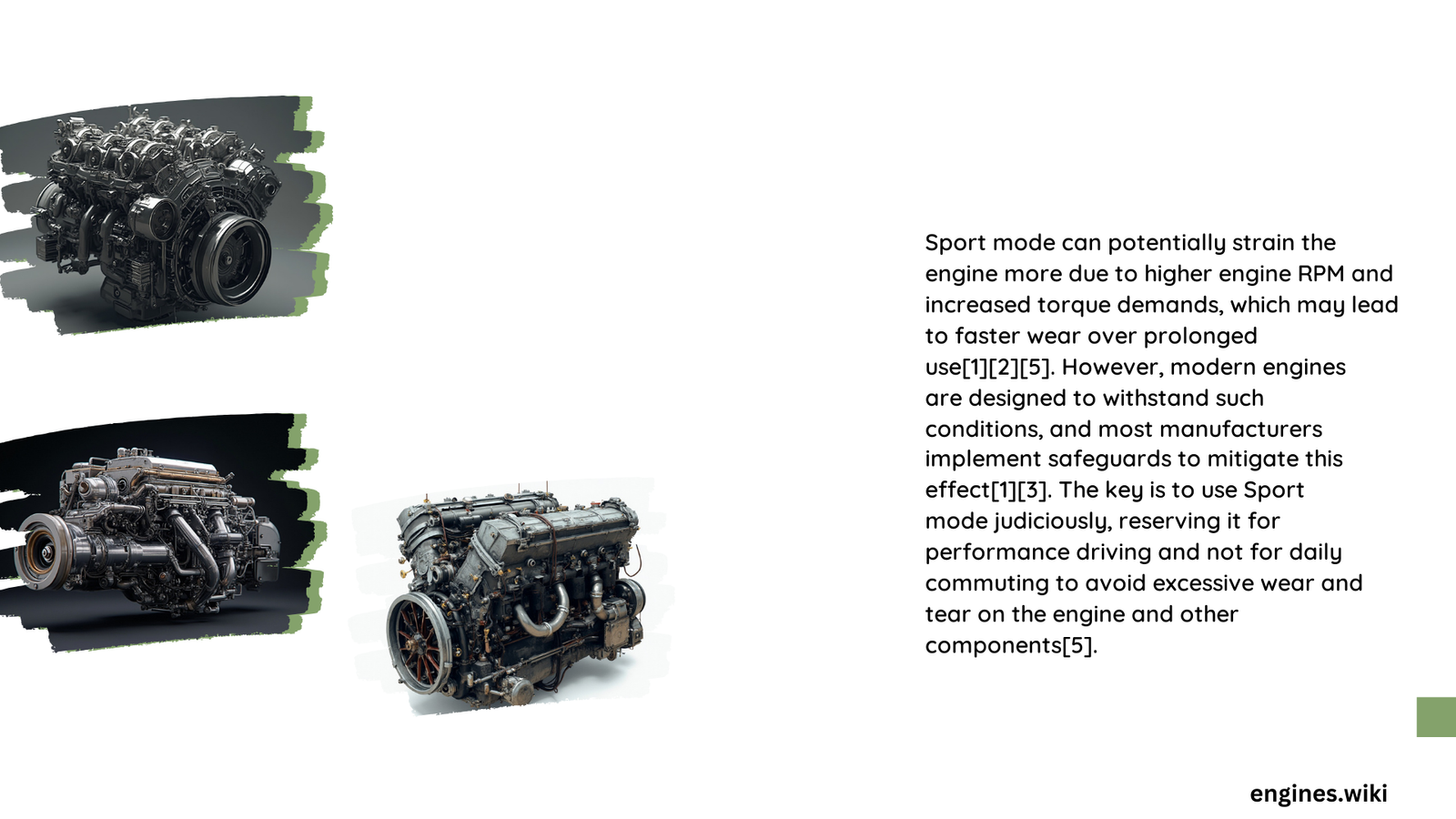Sport mode in vehicles is designed to enhance performance by altering engine and transmission behavior. While it can provide a more exhilarating driving experience, there are concerns about its impact on engine health. This article explores the effects of sport mode on engine wear, fuel efficiency, transmission stress, and overheating risks, providing insights into whether sport mode can potentially harm your engine.
What Are the Effects of Sport Mode on Engine Wear?
Sport mode typically increases engine RPMs and alters shift patterns, which can lead to increased wear on engine components over time. Here’s a breakdown of the potential impacts:
- Higher RPMs: Sport mode often keeps the engine running at higher RPMs, which can accelerate wear on moving parts such as:
- Pistons
- Connecting rods
- Crankshaft bearings
-
Valve train components
-
More frequent gear shifts: Aggressive shifting in sport mode can cause:
- Increased stress on the engine mounts
-
More rapid temperature fluctuations
-
Increased oil consumption: Higher RPMs may lead to:
- Faster oil breakdown
- Potentially higher oil consumption rates
While the exact increase in wear rate isn’t quantified, it’s generally accepted that more aggressive driving patterns associated with sport mode can lead to faster wear compared to normal driving modes.
How Does Sport Mode Affect Fuel Efficiency?

Sport mode prioritizes performance over efficiency, which typically results in increased fuel consumption. Here’s how it impacts fuel efficiency:
- City driving: Fuel efficiency can decrease significantly due to:
- Higher RPMs
- More frequent acceleration
-
Delayed upshifts
-
Highway driving: The impact may be less pronounced but still noticeable:
- Engine maintains higher RPMs
- Transmission may hold lower gears longer
| Driving Condition | Estimated Fuel Efficiency Impact |
|---|---|
| City | 10-20% decrease |
| Highway | 5-10% decrease |
Note: Actual figures may vary based on vehicle make, model, and driving conditions.
What Stress Does Sport Mode Put on the Transmission?
Sport mode can significantly increase stress on the transmission system. Here’s how:
- Delayed upshifts: The transmission holds lower gears longer, leading to:
- Increased heat generation
-
More wear on clutch packs (in automatic transmissions)
-
More aggressive downshifts: Can cause:
- Higher shock loads on transmission components
-
Increased wear on synchros (in manual transmissions)
-
Higher torque loads: Transmission components experience:
- Greater stress on gears and bearings
- Potential for accelerated wear if not properly maintained
To mitigate these effects, it’s crucial to:
– Follow manufacturer-recommended service intervals
– Use high-quality transmission fluid
– Allow the transmission to warm up before engaging sport mode
Does Sport Mode Increase the Risk of Engine Overheating?
Sport mode can indeed increase the risk of engine overheating, especially under certain conditions:
- Higher operating temperatures: Due to:
- Increased RPMs
- More frequent acceleration
-
Higher engine loads
-
Cooling system stress: The cooling system works harder to manage:
- Increased heat generation
-
More frequent temperature fluctuations
-
Oil temperature: Can rise more quickly, potentially leading to:
- Reduced lubrication effectiveness
- Increased engine wear
To minimize overheating risks when using sport mode:
– Ensure the cooling system is in good condition
– Monitor engine temperature gauges
– Avoid prolonged use in extreme conditions (e.g., hot weather, heavy traffic)
When Is It Safe to Use Sport Mode?
While sport mode can potentially increase wear and tear, it can be used safely under certain circumstances:
- Open roads: Less stop-and-go traffic reduces stress on the engine and transmission
- Short durations: Occasional use for brief periods is less likely to cause significant wear
- Proper warm-up: Ensure the engine and transmission are at operating temperature before engaging sport mode
- Cool weather: Lower ambient temperatures help mitigate overheating risks
Conclusion: Does Sport Mode Actually Hurt the Engine?
While sport mode doesn’t inherently damage the engine, it can accelerate wear and increase stress on various components if used excessively or improperly. The key to using sport mode without causing undue harm is moderation and proper vehicle maintenance.
To minimize potential negative effects:
1. Use sport mode sparingly
2. Follow manufacturer-recommended maintenance schedules
3. Pay attention to vehicle performance and warning indicators
4. Allow proper warm-up before engaging sport mode
By following these guidelines, you can enjoy the performance benefits of sport mode while minimizing the risk of premature engine wear or damage.
References:
1. Sport vs Normal mode – engine longevity | F150 Ecoboost Forum
2. Sport mode when first driving to warm oil up quicker.. yay or nay? | Rennlist
3. different rpms in C vs S modes – MBWorld.org Forums
